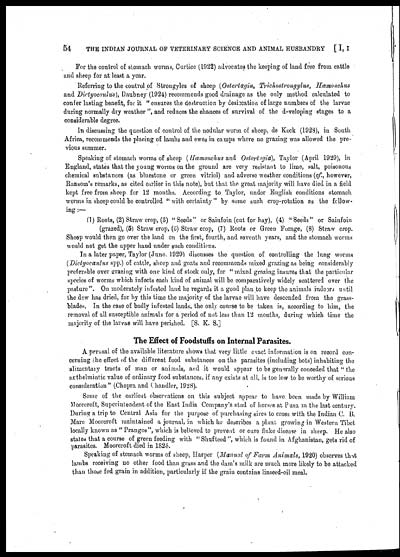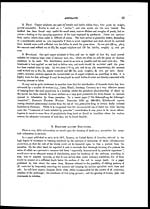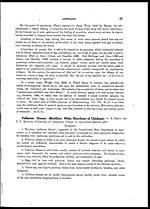Medicine - Veterinary > Veterinary colleges and laboratories > Indian journal of veterinary science and animal husbandry > Volume 1, 1931 > Part I (March 1931) > Abstracts
(88) Page 54
Download files
Individual page:
Thumbnail gallery: Grid view | List view

54 THE INDIAN JOURNAL OF VETERINARY SCIENCE AND ANIMAL HUSBANDRY [ I, I
For the control of stomach worms, Curtice (1922) advocates the keeping of land free from cattle
and sheep for at least a year.
Referring to the control of Strongyles of sheep (Ostertagia, Trichostrongylus, Hæmonchus
and Dictyocaulus), Daubney (1924) recommends good drainage as the only method calculated to
confer lasting benefit, for it " ensures the destruction by desiccation of large numbers of the larvae
during normally dry weather ", and reduces the chances of survival of the developing stages to a
considerable degree.
In discussing the question of control of the nodular worm of sheep, de Kock (1928), in South
Africa, recommends the placing of lambs and ewes in camps where no grazing was allowed the pre-
vious summer.
Speaking of stomach worms of sheep (Hæmonchus and Ostertagia), Taylor (April 1929), in
England, states that the young worms on the ground are very resistant to lime, salt, poisonous
chemical substances (as bluestone or green vitriol) and adverse weather conditions (cf., however,
Ransom's remarks, as cited earlier in this note), but that the great majority will have died in a field
kept free from sheep for 12 months. According to Taylor, under English conditions stomach
worms in sheep could be controlled " with certainty " by some such crop-rotation as the follow-
ing :—
(1) Roots, (2) Straw crop, (3) "Seeds" or Sainfoin (cut for hay), (4) "Seeds" or Sainfoin
(grazed), (5) Straw crop, (6) Straw crop, (7) Roots or Green Forage, (8) Straw crop.
Sheep would then go over the land on the first, fourth, and seventh years, and the stomach worms
would not get the upper hand under such conditions.
In a later paper, Taylor (June. 1929) discusses the question of controlling the lung worms
(Dictyocaulus spp.) of cattle, sheep and goats and recommends mixed grazing as being considerably
preferable over grazing with one kind of stock only, for " mixed grazing insures that the particular
species of worms which infects each kind of animal will be comparatively widely scattered over the
pasture". On moderately infested land he regards it a good plan to keep the animals indoors until
the dew has dried, for by this time the majority of the larvae will have descended from the grass-
blades. In the case of badly infested lands, the only course to be taken is, according to him, the
removal of all susceptible animals for a period of not less than 12 months, during which time the
majority of the larvae will have perished. [S. K. S.]
The Effect of Foodstuffs on Internal Parasites.
A perusal of the available literature shows that very little exact information is on record con-
cerning the effect of the different food substances on the parasites (including bots) inhabiting the
alimentary tracts of man or animals, and it would appear to be generally conceded that " the
arthelmintic value of ordinary food substances, if any exists at all, is too low to be worthy of serious
consideration" (Chopra and Chandler, 1928).
Some of the earliest observations on this subject appear to have been made by William
Moorcroft, Superintendent of the East India Company's stud of horses at Pusa in the last century.
During a trip to Central Asia for the purpose of purchasing sires to cross with the Indian C. B.
Marc Moorcroft maintained a journal, in which he describes a plant growing in Western Tibet
locally known as " Prangos ", which is believed to prevent or cure fluke disease in sheep. He also
states that a course of green feeding with " Shufteed ", which is found in Afghanistan, gets rid of
parasites. Moorcroft died in 1825.
Speaking of stomach worms of sheep, Harper (Manual of Farm Animals, 1920) observes that
lambs receiving no other food than grass and the dam's milk are much more likely to be attacked
than those fed grain in addition, particularly if the grain contains linseed-oil meal.
Set display mode to: Large image | Zoom image | Transcription
Images and transcriptions on this page, including medium image downloads, may be used under the Creative Commons Attribution 4.0 International Licence unless otherwise stated. ![]()
| Permanent URL | https://digital.nls.uk/75226058 |
|---|
| Description | Covers articles from 1931. |
|---|




